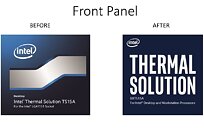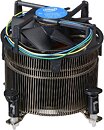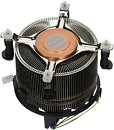Wednesday, May 27th 2020

Intel Issues PCN Reflecting LGA1200 Support for BXTS15A Boxed Cooler
Intel sells a beefed up sibling of its stock heatsink-fan separately in the DIY retail channel, called the Thermal Solution TS15A, which was originally released when Intel launched its LGA115x socket. With the new LGA1200 socket retaining cooler compatibility with LGA115x, Intel issued a PCN (product change notification) apprising its retail supply chain that a newer batch of the cooler will come with updated packaging to reflect that the cooler supports LGA1200 in addition to LGA1151. The TS15A features a copper core making contact with the processor's IHS at the base, from which aluminium fins project radially. A high power fan ventilates the cooler axially, while the cooler's design spreads some of the air onto the CPU VRM and memory.
Sources:
Intel PCN (PDF), via momomo_us (Twitter)





23 Comments on Intel Issues PCN Reflecting LGA1200 Support for BXTS15A Boxed Cooler
edit: I've searched for the copper cooler and all of them appear to be alloy with a copper core.
So basically Intel lied, and the picture is false marketing and clear bait and switch tactics.
(pic form hothardware)
A CPU cooler also barely affects the airflow in/out of case. Its not like its making any air, right? It just creates a different flow around the CPU area, but intakes and exhausts will still push the air through the case. You're suffering 90 degree angles no matter what.
The only limitation of topflow is the size issue. Its not easy making a big one and for heatsinks size matters in terms of the TDP they can take.
I'm a fan of this attempt, note the double heatsink
VRM cooling i won't be worried about though as my next mobo will be the msi x570 tomahawk. assuming it ever comes in stock
But then on the other hand they do not include a stock heatsink with their mainstream K and KF series (boxed obviously) CPU's. Obviously they assume people buying those already have their own cooler(s) or can procure them. Yet the same is not true for a GPU?.
And the one they do include is woefully inadequate despite producing a superior version for DIY market. Seriously - does anyone know anyone who has purchased this thing in the article instead of hunderds of better options available on the market?
Place the motherboard horizontally on a box or a testbed. Place the cooler on the CPU without any mounting hardware and let gravity do all the work. Done :D
Well some thermal paste is actually a good idea. I've run several test benches that way. Saves a lot of time but admittely works best with huge (1KG+) dual-tower coolers.
Most boards do just fine without a fan on the VRMs or the chipset so long as you have a good amount of air being push and pulled in and out of the case. The only time this could be an issue is when youre doing some extreme overclocking and need to set the voltage sky high or when youre running big clocks & a hot GPu but your ambient temp is 30'c+